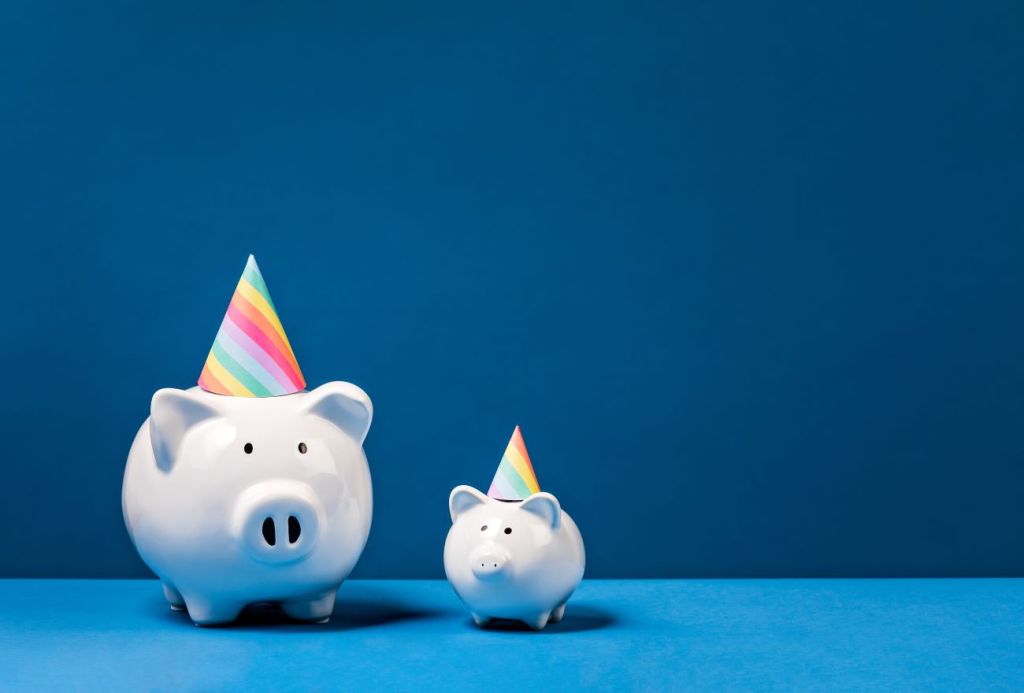“Neither a borrower nor a lender be….” Sounds like old Polonius in Shakespeare’s Hamlet never had to navigate the modern banking world. These days, borrowing and lending are baked into most of our day-to-day financial lives. Swiping a credit card is a form of borrowing money, while depositing funds into a savings account is technically lending money to your bank.
If you think about the big, hairy stuff that can be hard to afford up front—like a house, a car, a home reno, or a post-secondary education—you start to realize that debt is a reality for most people.
And where there’s borrowing, there’s interest! In this article, we walk you through the basics so you can explain them to your kids and teens: how to calculate interest, ways in which you earn or pay interest, and how interest rates are set in Canada.
Key takeaways
- Interest can be thought of in two ways: either as extra money earned through savings or extra money paid out on borrowed money.
- There are two types of interest: simple and compound. Both types are calculated using standard mathematical formulas—your scientific calculator can do the job.
- Interest is different from annual percentage rate, or APR, which includes charges such as handling fees.
- Interest is best earned by parking cash in a high-interest savings account (HISA) or a guaranteed investment certificate (GIC).
- Interest can be charged on all loan products: credit cards, lines of credit, car loans, and mortgages.
- Interest rates in Canada are determined by the policy rate set by the Bank of Canada.
- Lending institutions will factor in a person’s income, whether they have a down payment, and any assets to help determine interest rates on a loan.
- Comparing financial products is one of the best ways to find interest rates that work for you, whether you want to earn higher interest on savings or pay the lowest rate possible on a loan.
What is interest?
The simplest interest definition is this: an additional fee that’s charged for borrowing money. If you take out a loan or use a credit card, the lender charges loan interest. On the flip side, if you keep money in a savings account or invest it elsewhere, you will receive interest.
Whether you know it or not, cash travels far and wide. In its physical form, a toonie can go from one end of the country to the other, bouncing from convenience store to tip jar to donation box. The same is true of investments, savings, and loans. While you’re fast asleep, your money travels from your bank account to other banks, businesses, and even the upper chambers of government—and beyond.
Where does interest come in? You can think of it as a toll paid for getting your money from place to place. Sometimes you’re the one receiving the fare; sometimes you’re the one paying it.
Read more about how does interest work.
Types of interest
How you calculate interest on a loan or a savings account can differ depending on the type of lending or borrowing. Broadly speaking, interest falls into two different categories: simple interest and compound interest. Let’s break it down by looking at how they each work if your money earns interest:
Simple interest
Simple interest is calculated on the initial loan amount (or the “principal”) and not on any additional interest earnings. It’s the most straightforward type of interest. For example, if you deposit $1,000 into a bank account that pays out 1.5 per cent annually in simple interest, you can expect to make $15 in interest every year—but not a penny more!
Compound interest
Compound interest is interest that builds on the initial investment, or principal, plus any interest that gathers on top of the principal. So if you deposit $1,000 into a bank account that pays out 1.5 per cent annually in compound interest, you can expect to make $15 in your first year, just shy of $15.25 the next year, and even more in following years. This increase comes from your initial investment plus whatever interest was added to the principal in the previous year. Compound interest is commonly calculated on products ranging from high-interest savings accounts to guaranteed investment certificates (GICs) to bonds.

How is interest calculated?
It’s math time! In all seriousness, learning how to calculate interest isn’t that tricky. Dust off your scientific calculator and follow along:
How to calculate simple interest
As mentioned above, simple interest is only paid out on your principal. You can calculate simple interest by multiplying the principal by the interest rate and then by the loan term. It looks like this:
Simple interest = (principal) [(yearly interest rate as a decimal) x (years in the loan term)]
Let’s go back to that $1,000 deposit, earning a simple interest rate of 1.5 per cent annually. If you wanted to find out how much you could earn in 10 years, it would look like this:
Simple interest = $1,000 (0.015 x 10) = $150
After 10 years, you will have made $150 in interest. When you add that to your principal, you have a total of $1,150. Not bad!
How to calculate compound interest
Say you invest your $1,000 in a savings account that pays out compound interest annually, or once a year, for 10 years. Here’s what that calculation would look like (note that ^ means “to the power of”):
Compound interest = (principal) [(1 + (yearly interest rate as a decimal) / years)] ^ [(number of times interest is compounded per year) (years in the loan term)]
The difference here is that the interest gets added to your principal year over year, so the interest you’re earning grows exponentially over your term length rather than just multiplying itself every year. When you consider a $1,000 investment compounding annually at a rate of 1.5 per cent, this is what it looks like numerically:
Compound interest equation:
= $1,000 [1 + (0.015 / 10)] ^ (1×10)
= $1,000 (1 + 0.0015) ^ 10
= $1,000 (1.0015) ^ 10
= $1,000 x 1.16054082503
= $1,160.54
Note that the above equation combines the principal and the interest for a total sum.
With compound interest, you can expect to make $160.54 in interest after 10 years, for a total of $1,160.54.
You may have noticed that the difference between simple and compound interest over 10 years on $1,000 is just $10.54. But the bigger your principal, and the longer you keep investing, the more you can expect that figure to snowball.
What is APR?
When you apply for a credit card, a car loan, mortgage or other types of debt, you might see the interest rate expressed as an APR, or annual percentage rate. An APR is a fixed percentage set by individual lenders that includes administrative and processing fees, insurance, closing costs, and other fees. Unlike plain old interest, the APR is the rate that is imposed on the total debt amount—not just the principal.
Because fees are different when it comes to these products, lenders use APR to give a snapshot of what you can expect to owe, making it easier for you to shop around for the best rate. In Canada, lenders are legally required to disclose the APR upfront, and the APR cannot be higher than 60 per cent according to section 347 of the Criminal Code of Canada. One exception is the provincially governed payday-loans industry, which has different APR rules per province.
Interest rate versus APR
Even though the basic premise is similar, APR and interest rates aren’t the same thing. Using the highway toll example again, if interest is the toll charge that you pay to drive down a length of road, the APR also takes into account traffic camera charges, enforcement fees, and transponder rentals for an all-in-one fee.
Interest is a simple and straightforward way of figuring out returns on your investments. It’s also part of a larger calculation that tells you how much you’re actually paying on more complicated loan products that have an APR.
How can I earn interest?
Interest is best earned in places where you can park cash: high-interest savings accounts and investments. When you put money into a savings account, for example, your bank may use this money and lend it out to other people and businesses. Depending on the type of account you have, a financial institution might pay you interest for this. Your money is still yours, and you won’t notice the balance going down, but that’s what happens behind the scenes.
Here are three types of interest-generating savings accounts:
1. High-interest savings account (HISA)
A HISA generates a little more interest than a standard savings account—the range is between 0.5 and 2 per cent, which is paid out monthly. This type of account is useful for keeping short-term savings for specific goals—for example, first and last months’ rent, an emergency fund, or a dream vacation.
Learn more about bank accounts for kids.
2. Guaranteed investment certificate (GIC)
A GIC is the set-it-and-forget-it interest-yielding savings product: You take a lump sum of money and make an agreement with your bank that you’re not going to withdraw it for a set period of time (usually between one year and five years, with shorter options available). In return, the bank offers you an interest rate, which can either be paid throughout the year in simple interest or continue to compound until your term ends. The interest rate on GICs offered by banks usually ranges from below one per cent to as high as three per cent; the longer you park your money, the higher the interest rate. The only drawback is that if you want to cash out early, you’ll likely get dinged with an early withdrawal fee.
3. Tax-free savings account (TFSA)
Anyone over the age of 18 with a valid SIN can open a TFSA. At first glance, a TFSA is a savings vehicle just like any other that earns interest over time. But as the Transformers song goes, there’s more here than meets the eye—a TFSA is a savings account that can contain savings accounts.
How? The money in your TFSA can be plain old cash, or it can take the form of stocks, bonds, ETFs, mutual funds, and more. For example, you could purchase a GIC from your bank and park it inside a TFSA.
Why bother? TFSAs offer two big advantages:
- Any interest earnings you make are tax-free (hence the name!), as are any withdrawals. Using the GIC example, if it’s not parked inside a TFSA, you must declare any interest earned on your federal tax return.
- There is no withdrawal fee or penalty for taking money out of the TFSA, with one exception: If your money is wrapped up in a non-redeemable GIC, it must be held until maturity.
Because there are tax incentives to keep money in a TFSA, the government sets annual limits on individual contributions. For 2022, it’s $6,000. However, any unused contribution room can roll over to the next year. For example, someone who turned 18 in 2018 and never contributed to a TFSA before can contribute up to $29,500 in 2022. If they go over that amount, they’ll have to pay a one per cent monthly penalty of the extra contribution.

Which account is right for me?
The best way to figure out what’s right for you is to think about your goals. Are you hoping to make the maximum amount of interest on some money that you may have to tap into later? Consider storing it in your HISA. Can you absolutely wait a few years before withdrawing your savings? Maybe a GIC or another investment vehicle like a TFSA is a better bet.
When do I pay interest?
You pay interest when you borrow money from a bank, financial institution, or other lender (sometimes even family members). Loans can be in the form of a credit card, a personal loan, a line of credit, a mortgage, or a student loan.
What you pay in interest differs between loan products. With a credit card, you only pay interest on the outstanding balance that you carry from month to month. So if you pay off your credit card bill in full every month, you won’t need to pay interest.
For mortgages, you pay interest on top of your payments, which can be on a weekly, biweekly, or monthly schedule, and you get to choose between a fixed interest rate and a variable interest rate.
Variable interest is subject to increases or decreases based on the prime lending rate (more on that below), while a fixed interest rate is one that you’re locked into for the length of your borrowing term. So if you’re on a fixed interest rate and the prime lending rate goes down, you can’t take advantage of that lower interest rate. At the same time, if the prime lending rate goes up, you don’t have to pay any more than what you’ve already agreed to pay.
Who determines interest rates?
Hoo, boy. Buckle in, here—learning how banks set national interest rates takes some concentration. Let’s begin at the top: the Bank of Canada.
The Bank of Canada is not a commercial bank where regular folks can stroll in to use the ATM. Instead, it’s where the big banks do their banking. The Bank of Canada oversees the entire nation’s financial system. It manages the country’s debt and finances, works with major financial institutions within Canada, and sets policy to keep inflation stable.
Just like how you might spot a friend if they’re low on cash and can’t afford pizza, Canada’s banks lend and borrow money among themselves all the time. But there’s one difference between you covering your friend’s pepperoni ’za and a bank loaning funds to another: You probably don’t charge your pal interest, but banks do (because that’s the cost of doing business at this scale).
The amount of interest that each bank pays to borrow from another bank is based on a rate set by the Bank of Canada and is called the “policy rate.” It’s also called the “target for the overnight rate,” since most banks settle their books overnight.
In order to continue trading at the policy rate, banks and other financial institutions then calculate a new baseline interest rate to pass on to their customers. This new interest rate is called the “prime lending rate.” When the Bank of Canada policy rate goes up, banks then typically charge their customers more interest, such as on a variable-rate mortgage, in order to make up for that increase. As a result, the prime lending rate for banking customers also goes up by roughly the same amount. When the Bank of Canada policy rate goes down, so should the prime lending rate at your local bank.
The prime interest rate in Canada is the anchor against which a bank bases individual interest rates for mortgages, personal loans, lines of credit, and even some credit cards.
What else determines my interest rate?
The prime lending rate is a big factor in determining how to calculate your interest rate, but it’s not the only one. The interest rate you pay is also influenced by other factors, including:
- The type of loan you’re taking out
- Your credit score and credit history
- The term length
- Your employment status, salary, and earnings
Together, these factors create a borrower profile that helps give banks an idea of how reliable a borrower will be in repaying their loan amount.
Read more about credit 101 for teenagers.
How to find a good interest rate
Whether you’re borrowing money or putting funds away for a future date, you don’t necessarily have to settle for the first interest rate that crosses your path. With a little digging, parents and teens can find the best rates available. Here’s how:
1. Shop around
Take a look at what different banks and lending institutions are offering. Poke around a few websites to compare rates, and don’t hesitate to call a financial institution directly and ask—you’re not wasting anyone’s time since lending money is what banks do! If you don’t qualify for the best rates today, ask how you can work toward qualifying tomorrow. A savvy bank will set aside time for you, because today’s teens are tomorrow’s lifetime banking customers.
2. Get a regular income
Lenders need to know that you can pay the loan back. Your having a regular paycheque tells them you can handle some debt on top of other expenses, such as food and rent, which could help lower the interest rate on a prospective loan.
3. Save for a down payment first
Not only does having a down payment for big-ticket items like cars or fancy exercise equipment lower your overall loan amount, it also shows your commitment to paying down the loan, which might garner you a better rate. Even if it doesn’t affect the interest rate, with a smaller loan you’ll pay less overall interest on the lower balance.
4. Have collateral
While teens likely don’t have much in terms of collateral—assets used to secure a loan such as real estate, a car, or investments—it’s still good to know that these assets can help lower interest rates on a loan later on. Collateral is attractive to lenders because if you can’t pay back the loan, they can simply take possession of the collateral.
5. Safeguard your credit history
The last factor that can determine your interest rate is your credit history. If you have a good or excellent credit score, a history of responsible debt repayment, and a secure job paying you a regular income, the bank has less worry about recovering its funds. A good credit score also means you may be able to negotiate a lower interest rate on loans.
On the other hand, having no or a low credit score, or any incurred debt, also influences the cost of borrowing. These factors may make you appear unreliable, so your lender could impose a higher interest rate or limit the amount you’re able to borrow.
While you won’t be able to control the prime lending rate or your credit card APR, you can improve your creditworthiness. The earlier you start building your credit score, the better a position you’ll be in when it’s time to take out a mortgage or small business loan.
Why it’s important to understand your interest rate
Whether you’re saving money or borrowing it, it’s important to compare financial products to understand what interest rates are available to you. Especially when considering a loan or a credit card with a high APR, you’ll want to understand exactly what fees are involved before you sign the paperwork. The difference of a few percentage points may not seem like much at first, but even small numbers can have a snowball effect on the total amount you’ll pay. And if the dollar value of what you owe doesn’t scare you, the impact on your credit score if you fall behind on payments might!
Paying interest may be hard to avoid, but the bright side is that earning it is relatively easy. By understanding the difference between simple interest and compound interest and maximizing interest earned while minimizing interest incurred through debt, teens will be well on their way to making smart financial decisions for life. And when they’re empowered to make their own day-to-day financial choices with the help of Mydoh, money-smart teens are much easier on their parents.
Download Mydoh and help build the foundation of financial literacy for your kids and teenagers.
This article offers general information only and is not intended as legal, financial or other professional advice. A professional advisor should be consulted regarding your specific situation. While the information presented is believed to be factual and current, its accuracy is not guaranteed and it should not be regarded as a complete analysis of the subjects discussed. All expressions of opinion reflect the judgment of the author(s) as of the date of publication and are subject to change. No endorsement of any third parties or their advice, opinions, information, products or services is expressly given or implied by Royal Bank of Canada or its affiliates.







